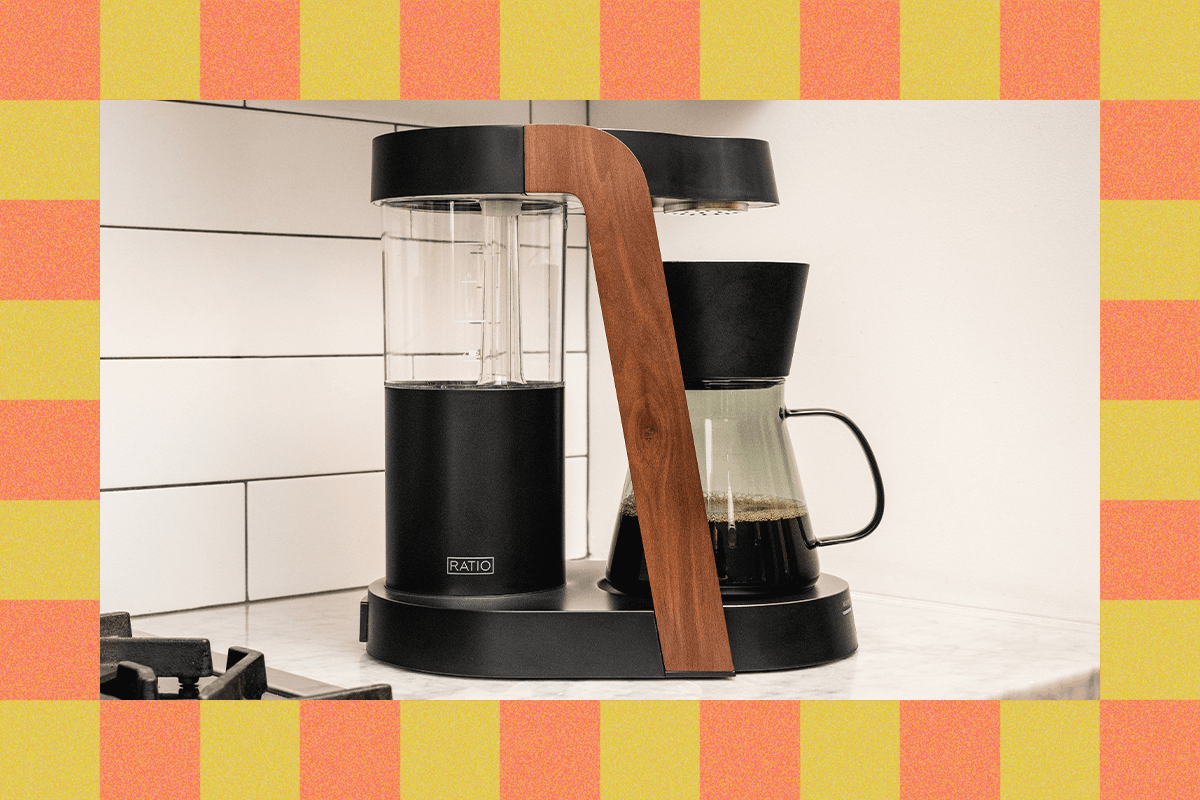All products featured on WIRED are independently selected by our editors. However, we may receive compensation from retailers and/or from purchases of products through these links.
I’ve made no secret about my love for coffee makers from the Portland-based company Ratio, ever since it came out with the Ratio Eight model a decade ago. Two of WIRED’s favorite drip coffee makers on earth are made by Ratio, in fact.
As well as anybody, the Portland company has managed to take the finicky techniques of third-wave barista pour-over and merge them with automatic drip coffee to create some of the most full-bodied and aromatic cups of coffee I’ve had the pleasure of tasting. To taste it, all I have to do is press a single button. The machine does the work, not me. The Ratio Four (8/10, WIRED Recommends) remains my favorite single-serve drip coffeemaker made by anyone, anywhere. It’s a masterclass in simplicity.
But it all began a decade ago with the Ratio Eight, which helped change the conversation around what a home drip coffeemaker could be, adopting the aesthetics and a lot of the techniques surrounding barista café pour-over but applying them to an automated home coffee machine— using locally hewn wood and the shapely curves of a Chemex-style pour-over coffeemaker.
Photograph: Matthew Korfhage
Well, now the Ratio Eight has gotten a makeover, for the new world of drip coffee it helped inspire—informed by all the coffee makers that Ratio has developed in the meantime (and even one they haven’t released). The new 8-cup Ratio Eight Series 2, slated for release in September, is now available for presale on Ratio’s website.
For a limited time, preorders are discounted to $639. But by September, when the Eight Series 2 is projected to go on sale for real, that price will shoot up to $799. That’s among the highest prices I’m aware of for a drip or pour-over coffee maker.
Is it worth it? I can say I got to try out the new Ratio Eight Series 2 at Ratio’s offices this week, just before preorders launched. I was very impressed by what I saw, and even more impressed by what I tasted. I won’t know everything until I get to play around with the device at home. But the coffee I had was full-bodied, full-flavored, and delicious. And it’s a beautiful machine.
Here are the specs on the upcoming Ratio Eight Series 2—and my early thoughts based on trying the device.
Ratio
Eight Series 2 Coffee Maker
Ratio Eight Series 2 Design Specs
Redesigned for More Consistent Coffee
If you’re a fan of the original Ratio Eight, chances are you were drawn in first by the aesthetics: the walnut wood accents. That pretty hourglass shape of the blown-glass carafe, with the conical brewing filter best known from café pour-over.
The sturdy walnut trim stayed. But Ratio has learned a few things since making the original Eight, said Ratio founder and CEO Mark Hellweg, at a meeting this month that also included the Eight’s designer, James Owen. One of the things Ratio learned is that using a closed, flat-bottom brewing chamber leads to much more consistent coffee than conical glass. It’s easier to control both in terms of water flow and brewing temperature, and is more forgiving if you don’t have a super-expensive grinder. (That said, you know, we like expensive grinders and recommend a few.)
“Once we went flat, we realized, ‘This is the way,’” said Hellweg.
I’ll admit, I’ll miss that pretty glass carafe, just on the visual level. Hellweg says they’ll indeed keep making the Chemex-style carafe as an option. But the Series 2, by default, will look much different, though it still has its hourglass shape as a link to the past.
Instead, the new brewing basket will make use of technology that Ratio developed when making two of my favorite coffeemakers, the Ratio Four and the Ratio Six Series 2, which consistently feel like magic tricks to me when I use them at home. I often find new homes for coffee makers I test. I keep my Ratios. Few others can manage such full-bodied, consistently thick extraction on automatic drip or pour-over-style coffee, while being so simple to use.
Photograph: Matthew Korfhage
Brews Like Café Pour-Over
The Ratio brewing method is somewhere between what a barista does in a third-wave café and a classic drip machine. First, there’s the “bloom,” which is a poetic name for pre-infusing coffee grounds with a small amount of hot water. This releases the carbon dioxide trapped in fresh beans, which would otherwise interfere with extraction when the hot water begins flowing in earnest.
Another thing that makes café pour-over coffee express flavor so well is agitation. Basically, if you drop water onto coffee, or shake it, or spin it, the coffee will release its secrets better. It’s like shaking an interrogation subject. (Actually, on second thought, don’t do this.)
One of Ratio’s signal technologies from the beginning has used a “Fibonacci-inspired” spiral showerhead, a shape often touted as a means of maintaining water efficiency. On the Eight Series 2, when Hellweg brewed a batch at Ratio’s Portland headquarters, this meant that water extracted evenly across the entire brew basket, with no obvious channeling. So the falling water droplets extract both faster and evenly.
Photograph: Matthew Korfhage
More Precise Temperature Control
Temperature control is a more interesting and complex conversation. Ratio is one of a small number of coffee-maker companies who’ve had their devices certified by the international Specialty Coffee Association as hewing to a very tight set of criteria, which includes holding temperatures within a tight 4-degree (Celsius) range during the entire brewing process.
But even this doesn’t tell the whole story. I can attest from experience that not all SCA-certified coffee makers produce great coffee—and that great coffee definitely can come from noncertified coffee makers. Ratio does a lot of sophisticated firmware rejiggering to play around with temperature curves during brewing—what chief operating officer Bradley Walhood, in an excitable moment, called “a literal crapload” of testing and firmware updates.
In the Eight, this means that they mess around with wattage to change how the heating element works. Though the Ratio Eight Series 2 is a 1,400-watt device, they intentionally don’t use all of it at all times, changing energy consumption in order to change how the heating element works over time and get the best-tasting brew.
Like Ratio’s previous Four, the Eight Series 2 will have two different brew modes for small and large batches of coffee, to further refine temperature curves and keep them in optimal ranges.
Plastic Contact Is Minimized
One of the biggest selling points on the Eight was always minimal plastic. There’s a lot of interest in plastic-free everything, in these days when new and frightening revelations about microplastics seem to come once a week.
But it’s difficult, and very expensive, to make a truly plastic-free automatic coffee machine. Plastic-free brewing is a bit of a holy grail, achieved mostly by much older, lower-tech methods like French press, moka pot, and pour-over.
The Eight Series 2 comes as close as any automatic drip machine to achieving this. The cold-water reservoir is a BPA-free Tritan copolymer. The base is also made of polymer. And there’s a bit of plastic used in the heating element that doesn’t come into contact with water, said Hellweg.
But the tubing, inside the device, is made of glass. The pipe connectors are silicone. The chassis is stainless steel, and so is the brewing basket. The thermal carafe is stainless steel, while the nonthermal option is borosilicate glass. What all this means is that heated water or coffee never touches plastic.
This also has the side effect of giving each part on the Eight a truly satisfying heft. “Check this out,” said Hellweg, with evident pride, handing me a small and weighty piece of steel that could double as a stress fidget. It was the lid to the water reservoir. It actually did feel good, the weight of this lid. Plastic makes you forget the satisfying solidity of cast metal. These more expensive materials are reflected, of course, in the price.
But It’s Quite Pricey
The preorder window offers a quite substantial discount on the anticipated retail price, but it’s still not low. The $639 preorder price for the Eight Series 2, and the $799 anticipated retail price in September, are at the very highest end of drip coffee machines on the market. They’re also double the price of Ratio’s own Six and Four.
Will the coffee alone justify this higher price? It’s hard to know based on one delicious carafe of coffee. That’s the sort of thing I’ll only learn over time, when testing side-by-side. Compared to the Ratio Six, the Eight Series 2 offers the same 40-ounce batch size but some new programming and new technology—including the ability to optimize its brewing program for small batches of 20 ounces or less.
But really, as with a lot of luxury goods, much of the cost is going into luxury: intangibles, style, loveliness, and of course, more expensive materials. In the case of the Eight Series 2, these costs will have a lot to do with the steps Ratio took to avoid plastic: the double-walled stainless steel, the borosilicate glass tubing, the American walnut wood. The new thermal carafe, with its stainless steel construction, is sturdy and lovely.
Ratio’s owners and designers also cited uncertainty surrounding tariffs, which is almost certainly a factor in announcing a price that’ll first take effect six months from now. The Eight Series 2, like a large portion of products from small companies in the United States, is manufactured in China because American factories aren’t set up for custom tooling on small production runs.
All I can say is that it’s pretty, and it brews delicious coffee, and it feels in my hand like a thing that costs what it does—in a year when a lot of things suddenly cost a bit more. But based on past experience with Ratio, the Eight Series 2 will probably remain the best-tasting cup of drip coffee I can get by just pressing a single button.




